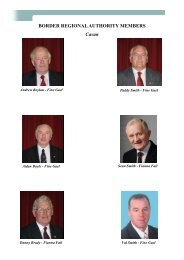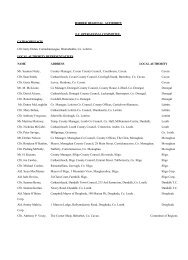downloads/RPGs/Border Regional Authority RPGs 2010-2022.pdf
downloads/RPGs/Border Regional Authority RPGs 2010-2022.pdf
downloads/RPGs/Border Regional Authority RPGs 2010-2022.pdf
Create successful ePaper yourself
Turn your PDF publications into a flip-book with our unique Google optimized e-Paper software.
<strong>Border</strong> <strong>Regional</strong> <strong>Authority</strong> Planning Guidelines <strong>2010</strong> – 2022 – CHAPTER 1<br />
1.14.4 SKILLS, EDUCATION & INNOVATION<br />
The changing sectoral profile of employment, presents a particular skills challenge for the <strong>Border</strong> Region.<br />
The challenge is all the more serious given the relatively lower levels of educational attainment within the<br />
Region, and a relatively high level of early school leaving - although this has reduced considerably in recent<br />
years. There is a low level of expenditure on R&D, within business and the Higher Education Institutes<br />
(HEI) - efforts are required to identify collaborative opportunities 7 .<br />
1.14.5 ECONOMIC INFRASTRUCTURES: ACCESS AND CONNECTIVITY<br />
The location of the <strong>Border</strong> Region, its cross-border relationships and potential opportunities, and its<br />
challenging/yet attractive physical environment, present certain connectivity challenges which need to be<br />
addressed in support of maximising the economic development potential of the Region.<br />
Significant progress has been achieved in terms of road access over recent years, and there now needs to<br />
be a clear understanding, north and south of the border, of the main transport corridors that must be<br />
developed.<br />
The development of Project Kelvin is a significant boost to the Region in terms of critical<br />
telecommunications infrastructure. However, additional investment will be required in broadband<br />
infrastructure throughout the Region.<br />
Air access is of immense importance to the Region underlining the need for good road transport links<br />
serving the international airports at Belfast and Dublin, and the need to maximise the impact of the four<br />
regional airports serving the Region: Sligo, Donegal, Derry and Knock.<br />
The Region benefits from interconnection to the Northern Ireland electricity grid and further integration of<br />
the grids north and south is planned. The transmission network in the North West requires significant<br />
reinforcement, and is essential if the significant un-tapped wind energy potential in this part of the Region is<br />
to be realised.<br />
1.14.6 PROTECTION OF BIODIVERSITY<br />
The <strong>Border</strong> Region encompasses an area of 12,156 sq. km. from the Atlantic Ocean on the West Coast to<br />
the Irish Sea on the East Coast. The Region is well endowed with a rich and diverse range of man- made<br />
and natural resources. One of the key strengths of the Region is its outstanding natural landscape that<br />
includes a wealth of biodiversity and a significant range of ecological sites of international and national<br />
importance. Along with its strong cultural and heritage assets, it can be seen as an area very suitable for a<br />
strong tourism base. The Region is the source of Ireland’s two longest rivers - the Shannon and the Erne,<br />
which is one of the world’s greatest waterways. It has a considerable coastal area and unique mountain<br />
ranges.<br />
One of the key development issues for the region is the proportion of the regional authority area that is<br />
designated as Natura 2000 sites (See Environmental Spatial Strategy Map), NHAs, National Parks and<br />
Nature Reserves as well as the number, range, and sensitivities of habitats and species of Irish and<br />
European importance that the region supports.<br />
These Guidelines will highlight the potential impact(s) of development on the above designated sites and<br />
develop a policy framework that will avoid adverse or significant impacts on these sites or provide the<br />
necessary mitigation, where appropriate, to maintain their conservation status and integrity.<br />
7<br />
Líonra, is a network of the seven third level colleges in the <strong>Border</strong>, Midlands and Western (BMW) Region of Ireland whose<br />
aim is to develop effective collaborative responses by the third level sector to the developmental needs of the BMW region.<br />
The group which was established in 2000 has recently announced a 'Collaborative Research and Innovation Strategy''.<br />
26






